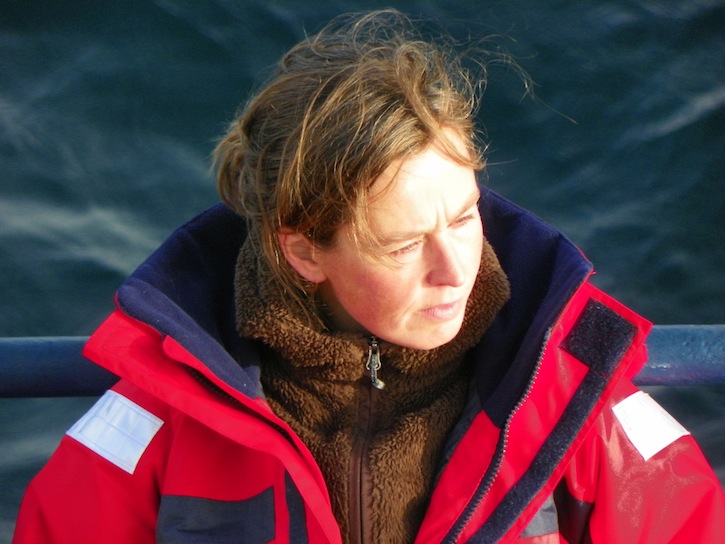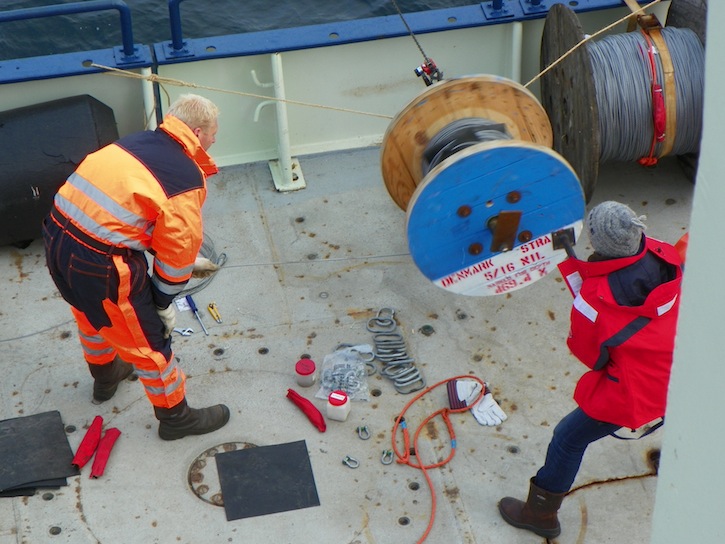The Royal Netherlands Meteorological Institute (KNMI) began a website to follow our cruise (http://www.knmi.nl/research/global_climate/oceaanexp/) in Dutch. Students were a part of their website, also. They have shared some of their questions and answers in English with us. Physical Oceanographer Laura de Steur, one of our science team who is from the Royal Netherlands Institute for Sea Research (NIOZ) answered their questions. Questions from our School Partner Kastanjepoort School in Erchim, Netherlands: How do you know exactly where the 12 buoys hang? We place the anchors so that we have the best possible measure of the currents in the Strait of Denmark. We do have some data from a cruise in 2008, so we know roughly where the two main currents are. The moorings are located about 7.5 km apart (a little over 4 miles) in these two strong currents around Iceland and Greenland. In between are two anchors to fill the gap. We know approximately how deep the Strait is and based on that, we determine the cable lengths between the instruments so that the top buoy will float about 100 meters below the surface, so it is not visible from the ship after it has been placed. But next year we will come back and will collect the whole mooring again. We are able to release the buoys from the anchor on the bottom and everything will float to the surface so that we can quickly collect them with the ship.
Physical Scientist Laura de Steur relaxes on the deck of the Knorr. © Pat Keoughan
You do measure the temperature of the water, how cold or hot is it now? Good question! The temperature of the water varies greatly: Near Greenland it is about -1 to 0 degrees Celsius (30-32 degrees F) in the upper 300 meters, below is a bit warmer, to about 1 degree Celsius (34 degrees F). But very close to the bottom at 1400 meters, the water is cold, about -0.5 degrees Celsius (31 degrees F). Close to Iceland the water is however much warmer, say, 8 to 12 degrees Celsius (46 to 54 degrees F). What does this mean? The flow near Greenland goes from north to south and transports cold water from the Arctic. The flow near Iceland goes from south to north and there hot water is being transported from the Atlantic Ocean to the north. Do you know why the water near Greenland, about -1 degree Celsius, is not frozen? Indeed, this water is not frozen because of the salt! Salt water freezes at a lower temperature than fresh water, which freezes at 0 degrees celsius. Sea water freezes only at -1.8 degrees celsius (29 degrees F). It is also well noted that water freezes much more slowly. That is also certainly true!
Laura de Steur and Leon Wuis, a science technician from the Netherlands, prepare the line for their mooring to be deployed the next day. © Pat Keoughan During deploying of anchors we saw a little boat sailing, why was that? A documentary was being made about the ocean and what is being investigated. So the cameraman was using the little boat to do all the work for his film. Sometimes he went into the water with a diving suit on to film the instruments going into the sea.
Questions from our School Partner Schateiland School in Gouda, Netherlands:
How was the selection of this crew made? There are actually two types of crew: the crew of the ship and the scientific crew. The crew of the ship is always working on board this ship, they send the ship to where the scientists want it to be, they keep all the engines working and they prepare the food (not unimportant!). We, the scientists, only go for 2 to 5 weeks to do our job. The ones who invented and prepared the research will become part of the team. There is always a group of students participating who are studying oceanography. Now we have six different nationalities on board: American, Icelandic, Norwegian, Dutch, German and English.
Does the melting of the poles affect the currents? This is a very good and interesting question. Today it gets lots of attention because it appears that the greenhouse gases that we emit heat up the atmosphere relatively quickly. Along some parts along the coast, the ice caps melt more at the South Pole (Antarctica) and in Greenland and that water flows into the sea. We can not predict exactly what will happen but we think that some currents may change. This is because, due to melting of land ice (ice) and sea-ice (the Arctic), more fresh water flows into the ocean. Fresh water has the property that it is lighter than salt water, in other words, fresh water floats on salt water. These density differences can alter currents and influence climate control. But how is not clear and therefore we want to survey the ocean and we do research into various currents to understand how they work and what their impact is on the great ocean circulation. We also try to simulate computer models of the ocean and climate and thus to understand what happens in the future.
Is there a difference in the currents during the seasons? That's a good question: probably, and we will only know that next year when we get the data back from the moorings in the Iceland Sea. Then we will have a whole year of data and we can see whether we can find a seasonal cycle. Maybe you should watch again next year with the next trip to this area when we pick up our moorings, then we will know more!
Last updated: December 27, 2011 | |||||||||||
Copyright ©2007 Woods Hole Oceanographic Institution, All Rights Reserved, Privacy Policy. | |||||||||||




